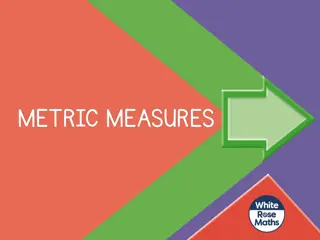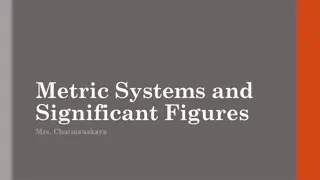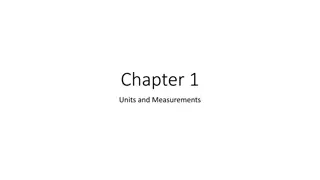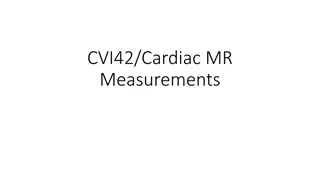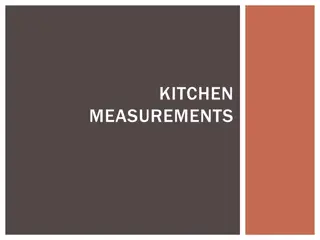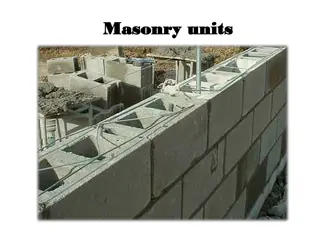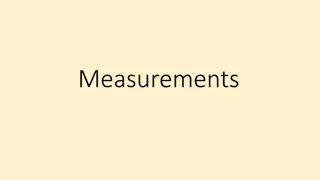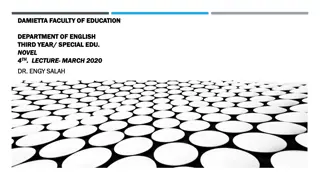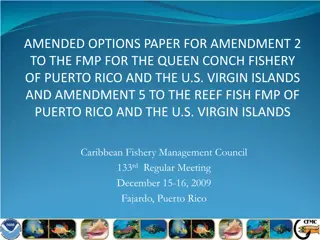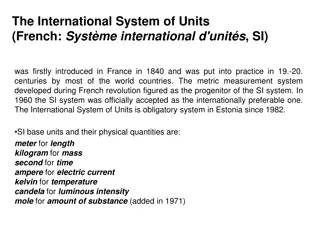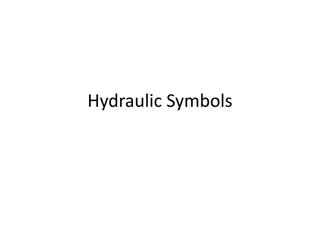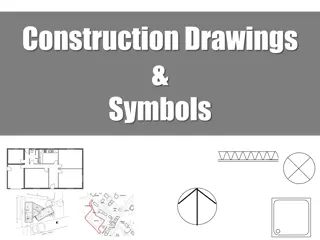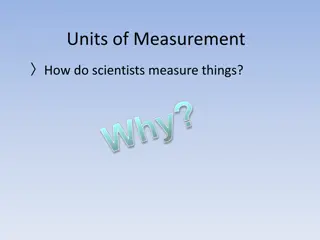Understanding Laboratory Measurements: Types, Units, and Symbols
Different types of measurements such as mass, time, volume, and length can be made in the laboratory using the metric or English system. Learn about the units, symbols, and instruments associated with these measurements for length, mass, volume, temperature, time, heat, and pressure. Explore how to measure mass, time, length, temperature, and heat energy in the lab with appropriate tools. Understand the importance of units like gram, liter, seconds, Celsius, and calories in scientific measurements.
Download Presentation

Please find below an Image/Link to download the presentation.
The content on the website is provided AS IS for your information and personal use only. It may not be sold, licensed, or shared on other websites without obtaining consent from the author. Download presentation by click this link. If you encounter any issues during the download, it is possible that the publisher has removed the file from their server.
E N D
Presentation Transcript
MEASUREMENTS There are different types of measurements that can be made in the laboratory like mass, time, volume, and length. These measurements can be made using either the metric system or the English system. The metric system is based on increments of 10. 1 base = 100 centibases c = centi 1 base = 1000 millibases m = milli 1 kbase = 1000 bases 1 base = 106microbases = micro k = kilo 1 base = 109nanobases n = nano The first step to understanding measurements is to learn the types, symbols, & units associated with these measurements.
MEASUREMENTS Unit Metric English There are different types of measurements that can be made in the lab for length, mass, volume, temperature, area, time, heat and pressure. Length Meter (m) Inches (in) or Feet (ft) Mass Gram (g) Pounds (lb) Volume Liters (L) Gallon (gal) Temperature Celsius ( C) and Kelvin (K) Fahrenheit ( F) Area Square meters (m2) Square feet (ft2) Time Seconds (s) Minutes (min) or Hours (hr) Heat Calories (cal) or Joules (J) British Thermal Units (BTU) Pressure Atmospheres (atm), Torr, or mmHg Pounds/sq in (lb/in2)
MEASUREMENTS A balance is used to measure mass in the laboratory. Metric Mass gram g Time is measured the same in both systems. A clock, wristwatch, or stopwatch will be used in the laboratory. Time seconds s hr English pounds lb..... hour minutes min
MEASUREMENTS Metric A ruler is used to measure length. Length meter m Area is defined as lengthxwidth, so a ruler is used. Area square meter m2 Volume is defined as lengthxwidthxheight so either a ruler or a graduated cylinder can be used. Volume Liter or cubic centimeter gallon, quart L cm3 English inches, feet in ft square feet ft2 gal qt
MEASUREMENTS TEMPERATURE A physical property of matter that determines the direction of heat flow. Temperature is measured with a thermometer. Measured on three scales. Fahrenheit oF Celsius oC Kelvin K oF = (1.8 oC) + 32 oC = (oF - 32)/1.8 K = oC + 273.15
MEASUREMENTS HEAT The relative heat energy that is transferred from one object to another can also be measured. Heat energy is usually measured in calories (cal) or joules (J). 1 cal = 4.184 J
MEASUREMENTS Putting it all together: Length (variable in a math equation = L ) symbol for units: cm stands for centimeter, mm is millimeters, m is micrometer, & nm is nanometer. Mass (variable m ) symbol for units: cg stands for centigram, mg is milligram, g is microgram, & ng is nanogram. Volume (variable V ) symbol for units: cL stands for centiliter, mL is milliliter, L is microliter, & nL is nanoliter.
MEASUREMENTS Since two different measuring systems exist, a scientist must be able to convert from one system to the other. CONVERSIONS Length Mass 1 lb.... = 454 g 1 kg = 2.2 lb.... 1 in = 2.54 cm 1 mi = 1.61 km Volume 1 qt = 946 mL 1 L = 1.057 qt 4 qt = 1 gal 1 mL = 1 cm3
Dimensional Analysis Dimensional Analysis (also call unit analysis) is one method for solving math problems that involve measurements. The basic concept is to use the units associated with the measurement when determining the next step necessary to solve the problem. Always start with the given measurement then immediately follow the measurement with a set of parentheses. Keep in mind, try to ask yourself the following questions in order to help yourself determine what to do next. 1. Do I want that unit? If not, get rid of it by dividing by it if the unit is in the numerator, (if the unit is in the denominator, then multiply). 2. What do I want? Place the unit of interest in the opposite position in the parentheses. Numerator Denominator
Dimensional Analysis 1. Let s try converting 15.0 L (microliters) into L (liters). 15.0 L L Start with what is given and then immediately write a set of parentheses after the measurement: 15.0 L ( ______) Next ask yourself: Do I want L? If the answer is no then get rid to L by dividing by that unit, that is, place it in the bottom of the parenthesis. 15.0 L(_______) = L Now ask yourself, What do I want? In this case it is liters (L) so the unit L should be placed in the numerator (top). 15.0 L (____ L__) = L Lastly place the correct numbers with the appropriate unit. Then plug the number into your calculator and the problem is solved. 15.0 L(__1 L__) = 1.5 x 10-5 L 1x106 L See that wasn t so bad?!
CONVERSIONS Convert the following: 1. 28.0 m To convert from m to mm you need to look up the relationship between meters (m) to millimeters (mm). There are 1000 mm in 1 m. 28.0 m ( 1000 mm ) = 28.0 x 104 mm 1 m Remember to ask yourself, do you want meters? No? Then get rid of it by placing it on the bottom in the parenthesis. What do you want? mm? Then put it on top in the parenthesis. This is Dimensional Analysis. 2. 65.9 lb kg Looking up the conversion, there are 2.2 lb. for every 1 kg. 65.9 lb ( 1 kg ) = 30.0 kg 2.2 lb mm
CONVERSIONS Convert the following: 1. 7.00 in3 There is no direct conversion from in3 to mL so now you will have to develop a multi-step process that will start with in3 and end with mL. If you memorize that 1 mL = 1 cm3, this problem becomes easy. All you need to look up is the relationship between in and cm. 1 in = 2.54 cm mL 1 mL = 1 cm3 7.00 in3 ( 2.54 cm )3 ( 1 mL ) = ? 1 in1 cm3 Place the conversion inside the parenthesis and the cube on the outside. Then cube the number inside the parenthesis. 7.00 in3 ( 16.387 cm3 ) ( 1 mL ) = 115 mL 1 in31 cm3
CONVERSIONS & WORD PROBLEMS Now it is time to apply these techniques to word problems. Nothing changes but it helps if you separate the words from the numbers. Therefore your first step should be to make a list. 1. How many miles will a car drive on 23.0 L of gasoline if the car averages 59.0 km/gal? mi = ? 23.0 L Note that mi & km are units for length and L & gal are units for volume. Looking at the units you should notice that you will need to convert km to mi and L to gal so list the conversion factors you will use. You can only convert units of the same measurement type (You can not directly convert km to gal, unless there is an additional stipulation connecting the two units like the 59.0 km/gal. 1 mi = 1.61 km 1 L = 1.0567 qt Always start with the single unit measurement: 59.0 km / gal 4 qt = 1 gal 23.0L (1.0567 qt ) (1 gal) ( 59.0 km ) (_1 mi_) = 223 mi 1L 4 qt 1 gal 1.61 km
PRACTICE STUDY PROBLEM #2 A study of gemstones and dimensional analysis: The basic unit for gemstones is the carat. One carat is equal to 200 milligrams. A well-cut diamond of one carat measures 0.25 inches exactly in diameter. Right click for answers _____ 1. The Star of India sapphire (Al2O3, corundum) weighs 563 carats. What is the weight of the gemstone in milligrams? _____ 2. The world s largest uncut diamond (C, an allotrope of carbon) was the Cullinan Diamond. It was discovered 1/25/1905 in Transvaal, South Africa. It weighed 3,106 carats. Calculate this weight in grams. _____ 3. The Cullinan Diamond was cut into nine major stones and 96 smaller brilliants. The total weight of the cut stones was 1063 carats, only 35% of the original weight! What weight (in kilograms) of the Cullinan Diamond was not turned into gemstones? _____ 4. Emerald is a variety of green beryl (Be3Al2Si6O18) that is colored by a trace of chromium, which replaces aluminum in the beryl structure. The largest cut emerald was found in Carnaiba, Brazil Aug. 1974. It weighs 86,136 carats. Assuming the diamond carat to size relationship stands for emeralds, calculate the approximate diameter of this stone in meters. _____ 5. The largest cut diamond, the Star of Africa, is a pear-shaped diamond weighing 530.2 carats. It is 2.12 in long, 4.4 cm wide, and 250 mm thick at its deepest point. What is the minimum volume (in liters) of a box that could be used to hide this diamond. 1.13 x 105 mg 621.2 g 0.3948 kg 546.96 m 0.59 L
GROUP STUDY PROBLEM # 2 _____1. Water boils at 212 oF, what is the boiling point of water in oC? _____2. What is the boiling point of water in Kelvin? _____3. Convert 25.0 ng to cg _____4. Convert 25.0 kJ to cal _____5. Convert 25.0 lb to mg _____6. Convert 25.0 ft3 to L _____7. How many liters of gasoline will be used to drive 725 miles in a car that averages 27.8 miles per gallon? _____8. Diamonds crystallize directly from rock melts rich in magnesium and saturated carbon dioxide gas that has been subjected to high pressures and temperatures exceeding 1677 K. Calculate this temperature in Fahrenheit. _____9. D.J. promised to bake 200 dozen cookies and deliver them to a bake sale. If each cookie weighs 3.5 ounces, how many kilograms will 200 dozen cookies weigh? _____10. One box of envelopes contains 500 envelopes. A case of envelopes contains 8 boxes of envelopes and cost $38.49. What is the cost, in cents, of an envelope?




